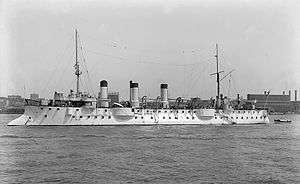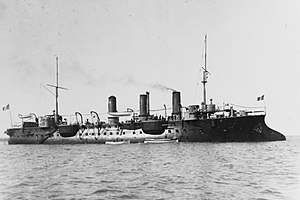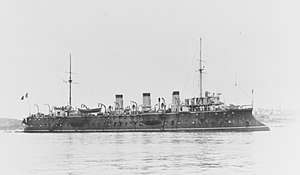Friant-class cruiser
The Friant class was a class of protected cruisers of the French Navy. The class comprised Friant, Bugeaud and Chasseloup Laubat.
 Chasseloup Laubat in the United States in 1907 | |
| Class overview | |
|---|---|
| Name: | Friant class |
| Builders: |
|
| Operators: |
|
| Preceded by: | Alger class |
| Succeeded by: | Linois class |
| Built: | 1891–1896 |
| In commission: | 1895–1920 |
| Completed: | 3 |
| Retired: | 3 |
| General characteristics | |
| Type: | Protected cruiser |
| Displacement: | 3,809–3,982 long tons (3,870–4,046 t) |
| Length: | 94 m (308 ft 5 in) pp |
| Beam: | 12.98 m (42 ft 7 in) |
| Draft: | 6.30 m (20 ft 8 in) |
| Installed power: |
|
| Propulsion: |
|
| Speed: | 18.7 knots (34.6 km/h; 21.5 mph) |
| Range: | 6,000 nmi (11,000 km; 6,900 mi) at 10 kn (19 km/h; 12 mph) |
| Complement: | 339 |
| Armament: |
|
| Armor: |
|
Design
In response to a war scare with Italy in the late 1880s, the French Navy embarked on a major construction program in 1890 to counter the threat of the Italian fleet and that of Italy's ally Germany. The plan called for a total of seventy cruisers for use in home waters and overseas in the French colonial empire. The Friant class were the first group of protected cruisers to be authorized under the program.[1][2]
General characteristics and machinery

The ships of the Friant class were 94 m (308 ft 5 in) long between perpendiculars, with a beam of 12.98 m (42 ft 7 in) and a draft of 6.30 m (20 ft 8 in). They displaced 3,809 to 3,982 long tons (3,870 to 4,046 t). The ships' hulls featured a pronounced ram bow and a tumblehome shape, which were common characteristics of major French warships of the period. They had a flush deck with a sloped stern. Their superstructure consisted of a main conning tower with a bridge forward and a smaller, secondary conning tower aft. Each ship was originally to be fitted with a pair of heavy military masts with fighting tops, but stability problems with Friant forced them to be replaced with lighter pole masts carrying only observation positions. Steering was controlled by a single rudder. Their crew consisted of 339 officers and enlisted men.[3][4]
The ships' propulsion system consisted of a pair of triple-expansion steam engines driving two screw propellers. Steam was provided by twenty coal-burning water-tube boilers of the Niclausse type for Friant and the Lagrafel d'Allest type for Chasseloup-Laubat, while Bugeaud received twenty-four Belleville boilers. All of the ships' boiler rooms were ducted into three funnels. Their machinery was rated to produce 9,500 indicated horsepower (7,100 kW) for a top speed of 18.7 knots (34.6 km/h; 21.5 mph). During sea trials, Bugeaud reached 19 knots (35 km/h; 22 mph).[5] Coal storage amounted to 577 long tons (586 t),[3] which provided a cruising range of 6,000 nautical miles (11,000 km; 6,900 mi) at a speed of 10 knots (19 km/h; 12 mph).[6]
Armament and armor
._Pi%C3%A8ce_de_100_de_marine_-_Fonds_Berthel%C3%A9_-_49Fi1270_(cropped).jpg)
The ships were armed with a main battery of six 164 mm (6.5 in) 45-caliber guns. They were placed in individual pivot mounts; one was on the forecastle, two were in sponsons abreast the conning tower, and the last was on the stern.[3] They were supplied with a variety of shells, including solid, 45 kg (99 lb) cast iron projectiles, and explosive armor-piercing (AP) and semi-armor-piercing (SAP) shells that weighed 54.2 kg (119 lb) and 52.6 kg (116 lb), respectively. The guns fired with a muzzle velocity of 770 to 800 m/s (2,500 to 2,600 ft/s).[7]
The main battery was supported by a secondary battery of four 100 mm (3.9 in) Modèle 1891 guns, which were carried in pivot mounts in the conning towers, one on each side per tower.[3] The guns fired 14 kg (31 lb) cast iron and 16 kg (35 lb) AP shells with a muzzle velocity of 710 to 740 m/s (2,300 to 2,400 ft/s).[8] All of the primary and secondary guns were fitted with gun shields to protect their crews.[3]
For close-range defense against torpedo boats, they carried four 47 mm (1.9 in) 3-pounder Hotchkiss guns and eleven 37 mm (1.5 in) 1-pounder guns, all in individual mounts; these were distributed around the ships, including atop the sponsons for the main guns. They were also armed with two 350 mm (14 in) torpedo tubes in her hull above the waterline.[3]
Armor protection consisted of a curved armor deck that was 30 mm (1.2 in) thick on the flat, which increased to 80 mm (3.1 in) on the sloped sides, where it provided a measure of vertical protection. Above the deck at the sides, a cofferdam filled with cellulose was intended to contain flooding from damage below the waterline. Below the main deck, a thin splinter deck covered the propulsion machinery spaces to protect them from shell fragments. Their forward conning towers had 75 mm (3 in) thick plating on the sides. The gun shields were 50 mm (2 in) thick.[3]
Modifications

In addition to her military masts, Friant had four of her 57 mm guns removed to correct her stability deficiencies. Chasseloup-Laubat was fitted with bilge keels to improve her stability.[9]
Construction
| Name | Laid down[3] | Launched[10] | Completed[3] | Shipyard[3] |
|---|---|---|---|---|
| Friant | 1891 | 17 April 1893 | April 1895 | Arsenal de Brest, Brest |
| Bugeaud | June 1891 | 29 August 1893 | May 1896 | Arsenal de Cherbourg, Cherbourg |
| Chasseloup-Laubat | June 1891 | 17 April 1893 | 1895 | Arsenal de Cherbourg, Cherbourg |
Service history

Notes
- Ropp, pp. 195–197.
- Gardiner, pp. 310–311.
- Gardiner, p. 311.
- Brassey 1895, p. 23.
- France, p. 37.
- Garbett, p. 563.
- Friedman, p. 221.
- Friedman, p. 225.
- Weyl, p. 28.
- Gardiner & Gray, p. 193.
References
- Brassey, Thomas A. (1895). "Ships Building In France". The Naval Annual. Portsmouth: J. Griffin & Co.: 19–28. OCLC 496786828.
- "France". Notes on the Year's Naval Progress. Washington, D.C.: United States Office of Naval Intelligence. XV: 27–41. July 1896. OCLC 727366607.
- Friedman, Norman (2011). Naval Weapons of World War One: Guns, Torpedoes, Mines and ASW Weapons of All Nations; An Illustrated Directory. Annapolis: Naval Institute Press. ISBN 978-1-84832-100-7.
- Garbett, H., ed. (May 1904). "Naval Notes: France". Journal of the Royal United Service Institution. London: J. J. Keliher & Co. XLVIII (315): 560–566. OCLC 1077860366.
- Gardiner, Robert, ed. (1979). Conway's All the World's Fighting Ships 1860–1905. London: Conway Maritime Press. ISBN 978-0-85177-133-5.
- Gardiner, Robert & Gray, Randal, eds. (1985). Conway's All the World's Fighting Ships: 1906–1921. Annapolis: Naval Institute Press. ISBN 978-0-87021-907-8.
- Ropp, Theodore (1987). Roberts, Stephen S. (ed.). The Development of a Modern Navy: French Naval Policy, 1871–1904. Annapolis: Naval Institute Press. ISBN 978-0-87021-141-6.
- Sieche, Erwin F. (1990). "Austria-Hungary's Last Visit to the USA". Warship International. XXVII (2): 142–164. ISSN 0043-0374.
- Weyl, E. (1898). Brassey, Thomas A. (ed.). "Chapter II: The Progress of Foreign Navies". The Naval Annual. Portsmouth: J. Griffin & Co.: 19–55. OCLC 496786828.
| Wikimedia Commons has media related to Friant class cruisers. |